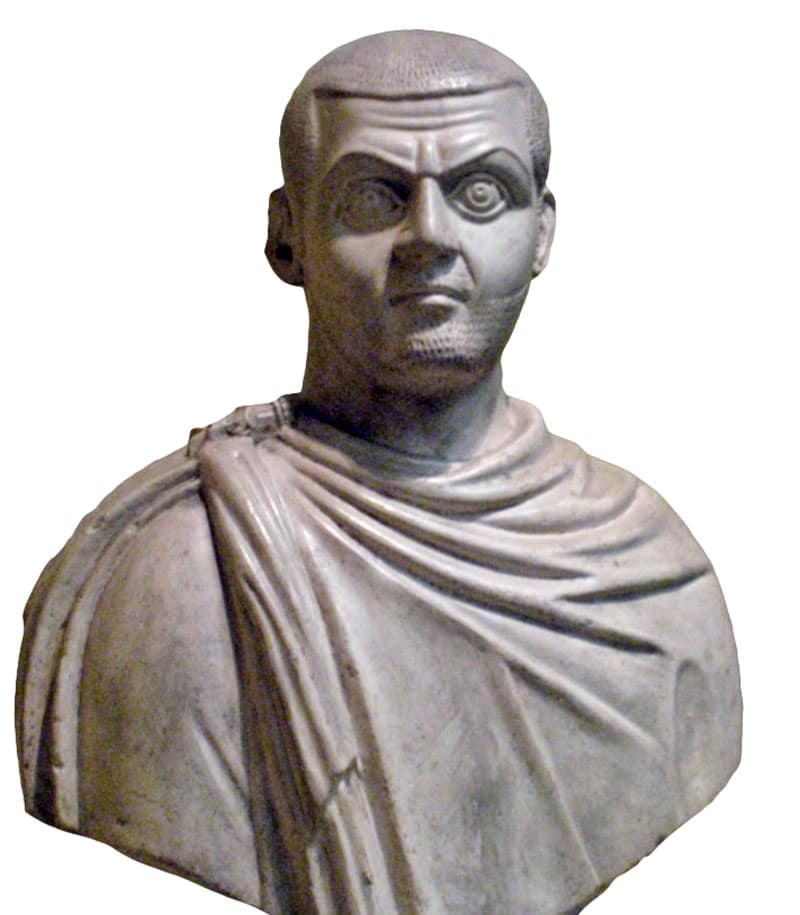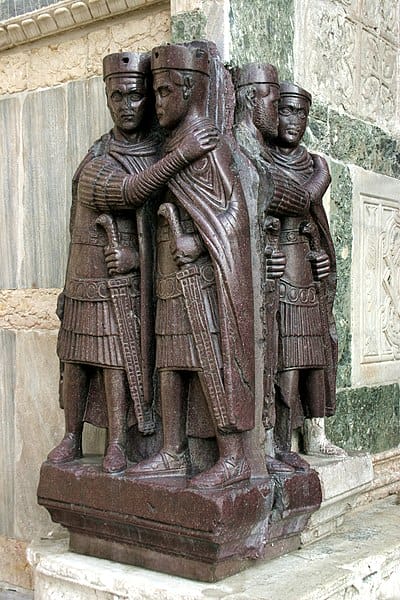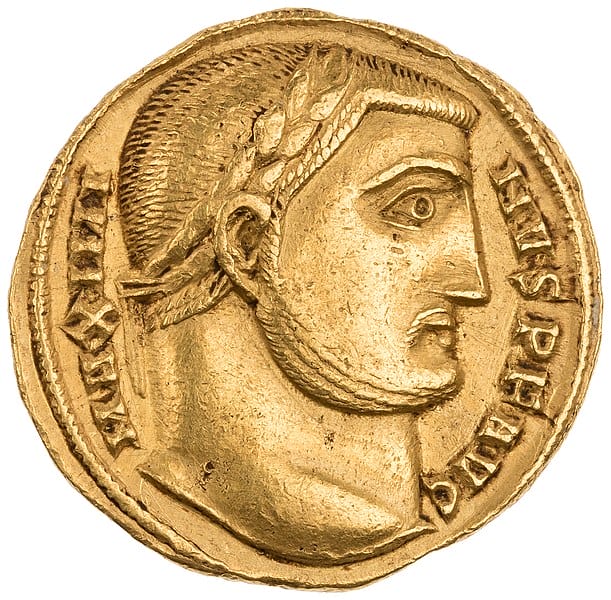Life: AD 270 – 313

- Name: Gaius Galerius Valerius Maximinus
- Born 20 November AD 270 in the Danubian region.
- Became emperor on 1 August AD 310.
- Wife: unknown (one daughter; unknown).
- Died at Tarsus July/August AD 313.
Early Life
Maximinus Daza (Also called “Maximinus II Daia”) was born on 20 November AD 270 in the Danubian region as the son of a sister of Emperor Galerius. He started his life as a herdsman of cattle but then joined the army. With his uncle Galerius’ rise to power, he advanced through the army at a very fast rate.
By the time of the joint abdication of Diocletian and Maximian in AD 305, he was serving as a military tribune and had been adopted as Galerius’ son. It was from this position of tribune that he was directly promoted to the rank of Caesar, with responsibility for the diocese of Oriens, which included the important provinces of Syria and Egypt. It is at the point of his accession to Caesar that he assumed the more regal name Gaius Galerius Valerius Maximinus. Meanwhile, to further strengthen the bond between himself and Galerius, his daughter was betrothed to Candidianus, the son of Galerius.
The Tetrarchy
The Tetrarchy was a system of government established by the Roman Emperor Diocletian in AD 293, aimed at addressing the challenges of governance and succession within the vast Roman Empire. By AD 308, the Tetrarchy had evolved into a complex system of four rulers, each with a designated junior co-emperor, effectively dividing the empire into four administrative regions or “dioceses.” At its core, the Tetrarchy consisted of two senior emperors, known as Augusti, and two junior emperors, known as Caesares. The system was designed to provide stability and ensure a smoother succession process by allowing for the retirement or elevation of rulers without risking civil war.
In AD 293, the Tetrarchy was composed by Diocletian, who was the senior Augustus and the architect of the Tetrarchic system. He ruled the Eastern part of the empire from Nicomedia (modern-day Turkey). Diocletian was known for his administrative reforms, including the division of the empire into smaller administrative units called dioceses and the institution of price controls known as the Edict on Maximum Prices.
Galerius was appointed as Augustus by Diocletian in AD 293 and ruled the Balkans and the Danube region from Sirmium (modern-day Serbia). He was known for his persecution of Christians during the Diocletianic Persecution, which was a significant event in early Christian history.

Constantius Chlorus was initially appointed as Caesar under Maximian and was later elevated to Augustus by Diocletian in AD 305. He ruled Gaul and Britain from Trier (modern-day Germany). Constantius Chlorus was the father of Constantine the Great, who would go on to become the first Christian emperor of Rome.
Maxentius was the son of the former Emperor Maximian and was appointed Caesar by his father. He ruled Italy and Africa from Rome. Maxentius’ rule was marked by instability and conflict, particularly with his father and with Constantine the Great.
Maximinus II quickly proved to be a fervent believer in the old Roman gods determined to repress the Christian faith. And so he continued the harsh policies introduced against the Christians under Diocletian. In AD 308, at the Conference of Carnuntum, Maximinus II Daza, together with the other Caesar Constantine, received a severe blow to their status as heirs to the Augusti when Galerius raised Licinius to the vacant position of co-Augustus.
The rules of the tetrarchy clearly would have demanded one of the Caesars to be promoted to this post, Constantine in particular, who was the western Caesar. But his close ties to Galerius obviously had built up Maximinus II’s hopes. If was Constantine disappointed, then Maximinus II was truly seething at this decision. His hostility towards Licinius was to remain a constant reminder of this denial of the status of Augustus in AD 308.
Becoming an Augustus
But for the moment, all who got to feel this anger were the Jews and the Christians. In AD 309, Maximinus II’s pagan fanaticism went so far as to demand that everyone, even babies, were to attend the public sacrifices to the state gods. For a while, Maximinus II Daza continued to sulk angrily at being passed over, but then, in AD 310, he took the decisive step and had himself acclaimed Augustus by his own troops. Galerius could do little else but accept the usurper in the east, perhaps even feeling sympathy for some of the ill feelings on his adoptive son’s side.
Maximinus likely had supporters among the military and bureaucratic elites who benefited from his rule. He came from a humble background and rose through the ranks of the military, which might have earned him favor among soldiers and those who valued meritocracy. Additionally, Maximinus continued the policies of his predecessors in promoting the traditional Roman religion and suppressing Christianity, which may have garnered support from traditionalists and those who opposed the spread of Christianity.
On the other hand, Maximinus faced criticism from various quarters. His persecution of Christians, like his predecessors, earned him condemnation from Christian communities within the empire. Additionally, his attempts to centralize power and assert control over various regions of the empire likely led to opposition from provincial elites and local populations who resented his heavy-handed rule.
In hindsight, Maximinus Daza’s reign is often viewed as a turbulent period marked by political instability and religious persecution. His attempts to consolidate power and suppress dissent ultimately contributed to the decline of the Tetrarchic system established by Diocletian. Maximinus II Daia is described by ancient historians as a vicious, boorish, and uneducated tyrant. Particularly when considering his brutal persecution of the Christians, this well appears to have been the case. But naturally, much of his legacy has been passed down by Christian historians who understandably displayed great bias against this emperor.
Was he no doubt a tyrant, then one perhaps must also consider that the surviving relatives of the emperors Severus II and Galerius chose to live in his domain rather than under the rule of the other emperors. In fact, Licinius did eventually see them all put to death.
Securing the Territories
When, in AD 311, Galerius died, both Licinius and Maximinus II knew they had to act fast to secure the territory of the dead Augustus. Both were clearly enemies ever since Licinius had been granted the throne of Augustus instead of Maximinus II.
Licinius was weak, only having Pannonia in his control, but the Balkan territories were within easy reach. However, Maximinus II found it easy to occupy all of Asia Minor (Turkey), with Licinius being powerless to do anything to prevent it. Then, with the armies of either emperor facing each other across the Bosporus, the two men agreed that the Bosporus was to be their border.

Had Galerius, on his deathbed, made his famous edict (possibly prompted by Constantine) by which toleration should be granted to the Christians, then Maximinus II only followed this for six months, after which he reverted back to his policy of persecution.
The Remodeled Pagan Cult
This persecution was now backed up with a potentially greater threat to the Christian church than the persecution itself. Maximinus II now remodeled the pagan cult system itself, following the example of the Christian church. This, in effect, created a pagan church with a similar organization and hierarchy to the Christian one. However, Maximinus II’s new persecution of the Christians was to be remembered most for its use of forged documents, by which he tried to discredit the Christian faith. Most notorious of all among those papers should be the infamous Acts of Pilate.
Maximinus II had strengthened his position by the occupation of Asia Minor but hoped most of all to find an ally in Maxentius, who controlled Italy and was also a traditional pagan. But in AD 312, Constantine’s victory over Maxentius at the Milvian Bridge put an end to such hopes. More so, Constantine used his newly enhanced authority to order Maximinus II to cease his persecution of the Christians. The latter reluctantly complied. No doubt, he realized that with Licinius and Constantine acting in favor of the Christians, any refusal on his part might have given them an excuse to jointly act against him.
Had Constantine made advances in the west, Maximinus II only suffered setbacks in the east. Failed harvests, plagues, robber bands on the loose, and a revolt by the Armenians decisively weakened his position at this moment. Maximinus II knew it inevitable that the current position of three hostile emperors could only result in civil war until one had achieved absolute power.
Constantine’s victory at the Milvian bridge made him the strongest of the three by far. And the ambitious Constantine was definitely the greatest threat. Though a war with Constantine was not possible, for the Libyan desert, he had no real border with any of Constantine’s territories. And so any action would have to be directed at his old enemy Licinius, who was Constantine’s ally, even engaged to his sister Constantia.
The March of Maximinus II Troups
Yet such things would change. If Constantine would ever get his hands on Licinius’ Danubian provinces, Maximinus II would stand no chance against a foe of such strength. Yet, if he could conquer Licinius’ territory himself, his strength would equal that of Constantine. With this in mind, Maximinus II marched his troops across Asia Minor (Turkey) in the winter of AD 312/313. It was freezing, as spring had not yet come.

Maximinus II’s idea was most likely to fold. Firstly, such an attack outside the warmer seasons traditionally used for warfare would take Licinius by surprise. Secondly, Constantine was occupied with the Germans on the Rhine, offering Maximinus II a golden opportunity to attack Licinius without his ally being able to come to his aid. If this was the plan, then the harsh, icy conditions imposed on his army were enormously demanding. Having crossed the Bosporus with 70’000 men, his luck held at first. The city of Byzantium surrendered to his force.
But Licinius, now aware of Maximinus II’s plans, marched against him. On 30 April or 1 May AD 313, the two armies met, Maximinus II controlling a force more than twice the size than that of Licinius. But after the forced marches across the frozen mountains of Asia Minor, his troops were exhausted. Simply too exhausted to fight, his army was utterly defeated.
The Escape of Maximus II Daza
Maximinus II escaped the slaughter and made his way back across the Bosporus disguised as a slave. With the army of Licinius in pursuit, he fled Asia Minor, hoping to re-group behind the Taurus mountain range and recover his position. He established his new headquarters at Tarsus and began to fortify the passes in order to prevent Licinius’ advance. But Licinius could not be held back. He broke through the Taurus mountains and laid siege to his Maximinus II at Tarsus.

The Death of Emperor Maximus Daza
Besieged by land and sea, Maximinus II’s situation was hopeless. At this point, he fell ill. Either this was due to disease or due to having taken poison to kill himself. In either case, he wasted away rapidly. Blinded and suffering, Maximinus II Daia died a miserable death in Tarsus in August AD 313. His death opened the door for a new era in religion.
Historians on Maximinus Daza
Historians have drawn upon a variety of ancient sources to construct their understanding of Maximinus Daza and his reign. These sources include contemporary accounts, later historical narratives, inscriptions, and archaeological findings. Among them, the most notable are Lactantius, Eusebius of Caesarea, and Zosimus.
The two first mentioned were Christiana authors who emphasized a critical perspective on Maximinus Daza and his persecution of Christians. They particularly mention the brutality of his regime and the suffering endured by Christians under his rule. These trials are described with a lot of details and Maximinus Daza is portrayed as a ruthless and evil prosecutor of the Christian faith.
A late Roman historian, Zosimus offers a different perspective on Maximinus Daza. In his “New History,” Zosimus presents Maximinus Daza as a capable military leader who faced challenges from rival claimants to the throne. While critical of his authoritarian tendencies, Zosimus also acknowledges Maximinus Daza’s efforts to defend the empire against external threats.
Legacy
In conclusion, Emperor Maximinus Daza, or Maximinus II, leaves behind a legacy that reflects the complexities of his era, particularly during the Crisis of the Third Century. As a skilled military leader, he played a crucial role in defending the Roman Empire against external threats, contributing to the stabilization of its frontiers. However, his reign was also marred by religious tensions, as he clashed with the rising influence of Christianity and implemented harsh measures against its followers.
Maximinus Daza’s authoritarian rule centralized power within the imperial administration but ultimately faced defeat at the hands of Constantine the Great, marking a turning point in Roman history. While his military achievements are acknowledged, his persecution of Christians and autocratic governance have left a controversial imprint on his historical legacy.
People Also Ask:
Who is Maximus Daza?
Maximinis Daia ruled over Roman Egypt and Syria from 305 to 313 and from 311 Anatolia as well. He was defeated by Licinius, after which he died painfully. He persecuted Christians until shortly before his battle with Licinius. He was the nephew of Galerius.
Which Roman emperor killed the most Christians?
The Augustus Diocletian ( r. 283–305) began the Diocletianic persecution, the final general persecution of Christians, which continued to be enforced in parts of the empire until the Augustus Galerius ( r. 310–313) issued the Edict of Serdica and the Augustus Maximinus Daia ( r. 310–313) died since Maximinus prosecuted Christians until the end of his life.
Who is the smartest Roman emperor?
Marcus Aurelius is one of the most revered emperors in history, known for his intellectual prowess; his personal writings on stoicism are considered some of the most comprehensive of all time.
Was Maximinus Thrax a real person?
He was a member of the Third Century Emperors dynasty. Coins for this issuer were issued from 235 until 238. Gaius Julius Valerius Maximinus was born in Thrace and began life as a lowly soldier.
What did Maximinus do to Christians?
Maximinus was a fervent pagan. In 306 and again in 308, he ordered a general sacrifice to the pagan gods; Christian recusants were mutilated and sent to the mines and quarries. (Outside of Egypt, there were few executions.)
Which emperor forced Christianity?
Constantine made Christianity the main religion of Rome, and created Constantinople, which became the most powerful city in the world. Emperor Constantine (ca A.D. 280– 337) reigned over a major transition in the Roman Empire—and much more.

Historian Franco Cavazzi dedicated hundreds of hours of his life to creating this website, roman-empire.net as a trove of educational material on this fascinating period of history. His work has been cited in a number of textbooks on the Roman Empire and mentioned on numerous publications such as the New York Times, PBS, The Guardian, and many more.
